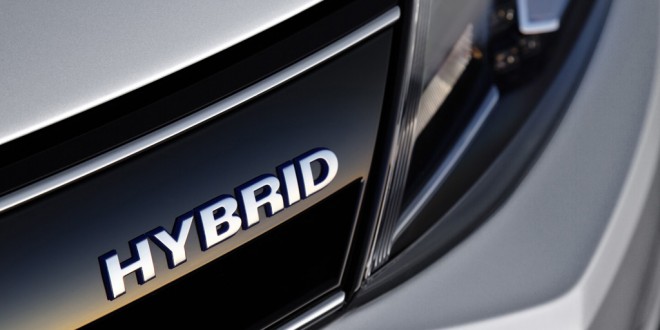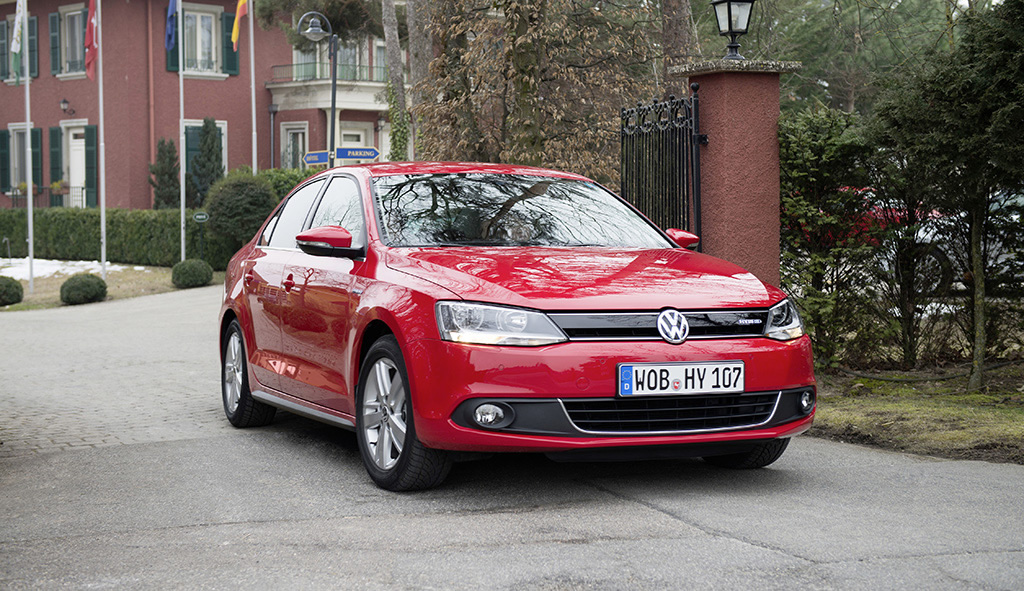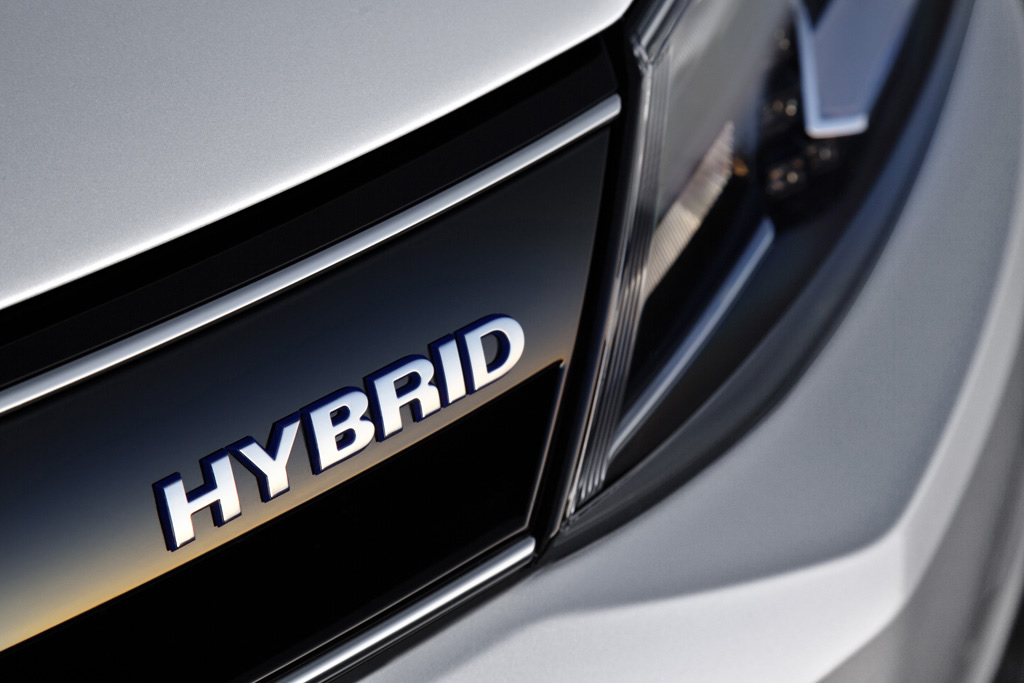2013 Volkswagen Jetta Hybrid
New Jetta Hybrid from Volkswagen drives in pure electric mode for up to two kilometers
Early this spring, in an European premiere, Volkswagen presented one of the most efficient cars in the world at the Geneva Motor Show: the Jetta Hybrid.
The Jetty Hybrid is powered by a high-tech petrol engine (TSI with 110 kW / 150 PS) and a zero-emissions electric motor (20 kW). Although this hybrid alliance facilitates outstandingly powerful driving performances (0-100 km/h in 8.6 seconds), the new Jetta Hybrid takes center stage with a combined fuel consumption of 4.1 l/100 km (or 95 g/km CO2). This means that the sporty saloon consumes about 20% less fuel than a comparably powered car with a conventional drive system.
When driving in the city, this fuel savings increases to 30 percent! Moreover, at the press of a button, the new Jetta Hybrid can be driven in pure electric mode, and therefore with zero emissions, at speeds of up to 70 km/h and over a distance of two kilometers (depending on terrain and operating conditions).
Extremely quiet. After the Touareg Hybrid, the Jetta Hybrid is now the second model from Europe’s most successful carmaker to have a drive module under the bonnet containing a petrol engine and an electric motor that are paired to attain the lowest possible fuel consumption values and excellent performance in all areas. Consider its comfort: in combination, the refined TSI, a newly designed exhaust system, use of an acoustic windshield, thicker side windows in front and various other measures have resulted in the quietest car Volkswagen has ever offered in this class. The market launch of the sporty and eco-friendly saloon began first in North America in late 2012; as of now, the new Jetta Hybrid can be ordered also in some European countries.
1.4 TSI is one of the world’s most advanced petrol engines. With a displacement of exactly 1,395 cm3, the downsizing four-cylinder engine develops a torque of 250 Nm at just over the idling speed (from 1,400 rpm). The show-stopper is: The TSI can maintain this constant high maximum torque up to 3,500 rpm. Together with the electric motor, the drive system exhibits performance characteristics that make the new Jetta Hybrid a sporty cruiser. Incidentally, the TSI is a lightweight unit weighing 98 kg.
TSI, decoupling clutch and E-motor form the hybrid module. The TSI, the electric motor and a decoupling clutch form the hybrid module. This is integrated between the two drives and fully disengages the petrol engine from the drivetrain when in pure electric driving mode or ‘sailing’ mode (coasting / braking).
State-of-the-art battery technology. A lithium-ion battery supplies the energy for driving the electric motor. The compact battery system is integrated behind the rear bench seat. Consequence: no compromises whatsoever in interior space. The battery is constructed of 60 individual cells, each with an energy capacity of 5 Ah; altogether, they produce a nominal voltage of 222 Volt and an energy capacity of 1.1 kWh. Weight: 35.8 kg. The frequent alternation of discharging and charging cycles in hybrid operation requires high-performance battery cooling, which in this case is handled by a fan mounted directly on the energy storage device. The battery also has its own management system that performs safety, diagnostic and monitoring functions as well as temperature management. Need-based control of the fan (as a function of such factors as outside temperature and momentary power demand) ensures that the battery continually operates within an optimal temperature window. Special protection systems also electrically disconnect the battery when not in use or in case of a crash.
Fast dual-clutch gearbox. Power transfer to the driven front axle is managed by a 7-speed dual clutch gearbox (DSG) that operates quickly and efficiently. The combination of a hybrid drive and DSG is unique here, because it merges driving fun with sustainability. Based on its low weight of 74 kg and very compact construction, the 7-speed dual-clutch gearboxsets the benchmark on this new level with torques of up to 250 newton meters. One thing is certain: Thanks to its lightweight drive components, the weight of the Jetta Hybrid was only increased by 100 kg despite the battery system. Together with additional safety modifications to the vehicle structure, the gross weight of the new Jetta Hybrid is still less than 1,500 kg.
Zero emissions driving by electric motor. When the battery of the Jetta Hybrid is sufficiently charged, the Volkswagen can, as mentioned, be driven over a distance of up to 12 kilometres in pure electric mode and therefore with zero emissions. The Jetta Hybrid is switched to electric drive mode either automatically (up to 60 km/h) or manually (up to 70 km/h) by pressing the E-mode button to the right of the gear shift lever. In both cases, the TSI is disengaged from the drivetrain by a decoupling clutch, which reduces energy consumption and increases the electric driving range. About one-third of the fuel-saving potential in the Jetta Hybrid is realised by electric driving.
Battery charging by regeneration. During braking, the Jetta Hybrid switches over to a battery regeneration mode, which ‘captures’ kinetic energy and feeds it into the battery as electrical energy. This is how it works: As soon as the driver releases the gas pedal to brake, the decoupling clutch opens to disengage the engine and reduce drag torque losses in this phase. If the driver now activates the brake pedal, the generating power of the electric motor increases – as a function of brake pedal travel – and the electrical energy produced in this way is stored in the battery. The energy is then available, either for electric driving or boosting. The effect of battery regeneration should not be underestimated; it represents another third of the fuel-saving potential realised in the Jetta Hybrid!
In city driving, the TSI is silent whenever possible. The Volkswagen’s petrol engine is shut off as soon as the car stops in city or stop-and-go traffic, provided that the driver presses the brake pedal and the battery is sufficiently charged. However, the heating, air conditioning system and electric convenience systems such as the audio system continue to operate. Interesting: Unlike in conventional systems, the Jetta’s petrol engine is not only stopped; the decoupling clutch also disengages the engine from the drivetrain to enable a pure electric driving mode when the car drives off again as an alternative to petrol engine driving – provided that the battery is sufficiently charged. Another third of the fuel-saving potential in the Jetta Hybrid is realised by frequent deactivation of the TSI.
‘Coasting’ without TSI. As soon as the driver releases the accelerator pedal at higher vehicle speeds (up to 135 km/h), the TSI is shut off and is also disengaged from the drivetrain via a decoupling clutch to eliminate drag torque losses in this driving situation. The consequence: The Jetta Hybrid coasts further than is usual, without consuming any fuel.
Double the power with boosting. If the DSG gear selector is in the ‘S’ gear position or the manual shift gate, the drive system reacts to vigorous accelerator pedal travel with maximum propulsive power. The same applies to the classic kickdown (a quick press of the accelerator all the way to the floor). In this case, the power of the E-motor and the TSI combine to output a temporary peak power of 125 kW / 170 PS, which is applied to the front wheels via DSG. In automotive jargon, this interplay of engine and motor is known as ‘boosting’. The extra power can be used to complete passing manoeuvres in the shortest of times, which improves active safety.
Driving with the petrol engine. On faster drives and/or when battery capacity is low, the Jetta Hybrid is powered by just the TSI engine. In these phases, the operating point of the TSI is also shifted to optimise efficiency; it delivers more power than is needed for pure propulsion. This excess power is utilised in a very specific way: depending on the battery’s momentary charge state, the extra power might be used to charge the high-voltage battery via the electric motor – which, in this case, acts as a generator. These so-called active charging phases are interspersed with electric driving phases to realise the best possible fuel economy.
New instruments. All relevant operating states are displayed by the instruments of the Jetta Hybrid. The driver calls up information via menus for the new instruments. Under the ‘Hybrid’ menu, the currently active drive mode is displayed in an energy flow diagram, and the direction of energy flow is visualised in the form of arrows. The battery charge state is shown on the same screen. Directly below the energy flow diagram is what is known as the ePower meter. This indicates the relative power of the electric motor. The ePower meter is only active in the ‘electric driving,’ ‘E-mode’ and ‘Boost’ operating modes.
Power meter shows power source of hybrid drive. Of central importance is the so-called Power meter (not to be confused with the ePower meter). The Power meter – a multifunctional display that replaces the tachometer and that is integrated on the left side of the instrument cluster – informs the driver of the momentary operating state of the Jetta Hybrid: a general readiness to drive (‘Ready’), battery regeneration (‘Charge’), eco-friendly driving mode (‘Eco’), boosting (‘Boost’) or pure internal combustion engine driving with the TSI (‘Off’). In addition, electric driving – either automatic or manually selected by the driver – is also indicated in the instruments (‘E-mode’).
Playfully visualising how efficiently one is driving. The audio system display plays a role in this information strategy. The goal here: a particularly efficient driving mode. To realise this goal, the ‘Zero emissions’ sub-menu offers a graphic display of the car’s driving time with zero emissions. The zero emissions values are shown in the form of percentages in a bar diagram, where the measurement interval of one bar represents one minute of driving. A value of 100 percent means that the Jetta Hybrid was driven with zero emissions throughout the driving minute, i.e. with the TSI engine shut off. A total time period of 30 minutes is considered.
 Asian Fortune Your source for all things Asian American
Asian Fortune Your source for all things Asian American


